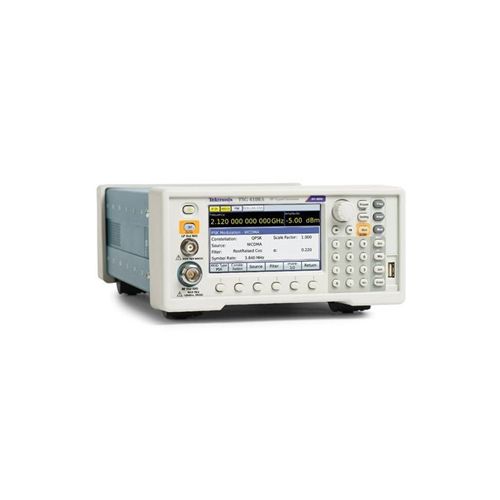Tektronix TSG4104A Vector Signal Generator
- True DC to 4GHz supports both analog and vector/digital signal generation
- Typical ±0.30dB amplitude accuracy (0dBm CW signal at 22?C) from 100MHz to 6GHz
- Analog modulation standard; low-cost soft key upgrade to vector/digital modulation
Midrange Performance. Entry-level RF Signal Generator Price.
Simply the best vector signal generator value on the market.
The TSG4100A Series is a vector signal generator with an affordable price tag of a basic signal generator, making it the first vector RF signal generator from a tier-one vendor with a price point of less than £10,000. It also complements other leading mid-range RF test solutions from Tektronix, such as the new USB-based RSA306 spectrum analyzer, MDO4000B and MDO3000 mixed domain oscilloscopes.
Product Features
- True DC to 4GHz supports both analog and vector/digital signal generation
- Typical ±0.30dB amplitude accuracy (0dBm CW signal at 22?C) from 100MHz to 6GHz
- Analog modulation standard; low-cost soft key upgrade to vector/digital modulation
- I/Q modulation inputs (400MHz RF BW)
- ASK, FSK, MSK, PSK, QAM, VSB, and custom I/Q waveform
- Digital modulation applications for GSM, EDGE, W-CDMA, APCO-25 (Phase 1), DECT, NADC, PDC and TETRA
- Compact: 2U high by ½ standard rack width; only 5.4kg
- A rich set of interfaces: LAN, RS-232, GPIB, USB
Analog modulation
The Tektronix TSG4100A Series RF Vector Signal Generators offer a wide variety of modulation capabilities. Modes include amplitude modulation (AM), frequency modulation (FM), phase modulation (ΦM), and pulse modulation. There is an internal modulation source as well as an external modulation input. The internal modulation source produces sine, ramp, saw, square, and noise waveforms. An external modulation signal may be applied to the rear panel modulation input. The internal modulation generator is available as an output on the rear panel.
Vector modulation
The TSG4100A Series builds on this performance by adding full support for vector signal modulation on RF carriers between 400 MHz and 6.0 GHz. It features a dual arbitrary waveform generator operating at 125 MHz for baseband signal generation. The generator has built-in support for the most common vector modulation schemes: ASK, QPSK, DQPSK, π/4 DQPSK, 8PSK, FSK, CPM, QAM (4 to 256), 8VSB, and 16VSB. It also includes built-in support for all the standard pulse shaping filters used in digital communications: raised cosine, root-raised cosine, Gaussian, rectangular, triangular, and more. Lastly, it provides direct support for the controlled injection of additive white Gaussian noise (AWGN) into the signal path.
Internal baseband generators
Using a novel architecture for I/Q modulation, the TSG4100A Series provides quick, user-friendly waveform generation. The baseband generator supports the playback of pure digital data. It automatically maps digital symbols into a selected I/Q constellation at symbol rates of up to 6 MHz and passes the result through the selected pulse shaping filter to generate a final waveform updated in real time at 125 MHz. This baseband signal is then modulated onto an RF carrier using standard IQ modulation techniques.
Digital communications protocols (GSM, GSM EDGE, W-CDMA, APCO-25, DECT, NADC, PDC, and TETRA) quickly configure the signal generator to the correct modulation type, symbol data rates, TDMA duty cycles, and digital waveform filters. The preset protocols also configure the rear-panel TDMA, START of FRAME, and SYMBOL CLOCK digital outputs. The baseband generators can be configured for these protocols without the use of external computers or third party software.
The I/Q waveforms are computed in real time. Symbols are mapped to constellations, digitally filtered, and up-sampled to 125 Msps to drive the I/Q modulator via dual 14-bit DACs. The symbols can be a fixed pattern, PRBS data from an internal source, or come from a downloaded user list of up to 16 Mbits.
The constellation mapping can be modified by the user. Digital filters include raised cosine, root raised cosine, Gaussian, rectangular, linear, sinc, and user-defined FIR.
External IQ modulation
The rear-panel BNC I/Q modulation inputs and outputs enable arbitrary vector modulation via an external source. The external signal path supports maximally 400 MHz of RF bandwidth with a full scale range of ±0.5 V and a 50 Ω input impedance.
Power vs. frequency
All TSG4100A Series models have cascaded stages of amplifiers and digital attenuators to drive the RF output. Five stages can provide up to +25 dB of gain to -130 dB of attenuation in 156 digitally controlled steps. During factory calibration, the output power is measured at 32 frequencies per octave for each of the 156 attenuator steps to populate a memory matrix with about 40,000 elements. When set to a particular frequency and power, the instrument interpolates between these matrix elements to determine the best attenuator setting. An analog attenuator is used to provide 0.01 dB resolution between matrix elements and to compensate for residual thermal effects.
OCXO time-base
These instruments offer an oven-controlled crystal oscillator (OCXO) time-base. The time-base uses a third-overtone stress-compensated 10 MHz resonator in a thermostatically controlled oven. The time-base provides very low phase noise and very low aging.
Easy remote communications
Remote operation is supported with RS-232, LAN, and GPIB interfaces. All instrument functions can be controlled and read over any of the interfaces. Up to nine instrument configurations can be saved in non-volatile memory.
Price on application - Please call 0800 583 4455 or email sales@sjelectronics.co.uk

